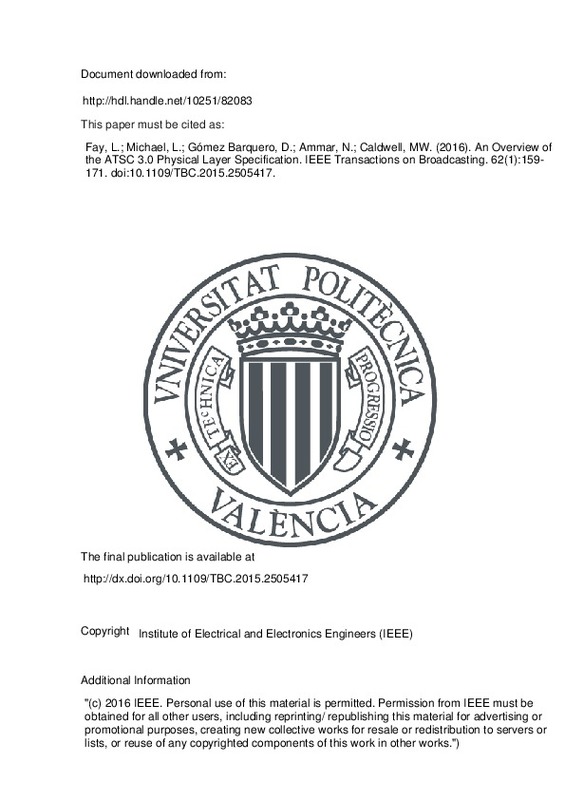JavaScript is disabled for your browser. Some features of this site may not work without it.
Buscar en RiuNet
Listar
Mi cuenta
Estadísticas
Ayuda RiuNet
Admin. UPV
An Overview of the ATSC 3.0 Physical Layer Specification
Mostrar el registro sencillo del ítem
Ficheros en el ítem
| dc.contributor.author | Fay, Luke
|
es_ES |
| dc.contributor.author | Michael, Lachlan
|
es_ES |
| dc.contributor.author | Gómez Barquero, David
|
es_ES |
| dc.contributor.author | Ammar, Nejib
|
es_ES |
| dc.contributor.author | Caldwell, M. Winston
|
es_ES |
| dc.date.accessioned | 2017-05-31T10:03:16Z | |
| dc.date.available | 2017-05-31T10:03:16Z | |
| dc.date.issued | 2016-03 | |
| dc.identifier.issn | 0018-9316 | |
| dc.identifier.uri | http://hdl.handle.net/10251/82083 | |
| dc.description | "(c) 2016 IEEE. Personal use of this material is permitted. Permission from IEEE must be obtained for all other users, including reprinting/ republishing this material for advertising or promotional purposes, creating new collective works for resale or redistribution to servers or lists, or reuse of any copyrighted components of this work in other works.") | es_ES |
| dc.description.abstract | This paper provides an overview of the physical layer specification of Advanced Television Systems Committee (ATSC) 3.0, the next-generation digital terrestrial broadcasting standard. ATSC 3.0 does not have any backwards-compatibility constraint with existing ATSC standards, and it uses orthogonal frequency division multiplexing-based waveforms along with powerful low-density parity check (LDPC) forward error correction codes similar to existing state-of-the-art. However, it introduces many new technological features such as 2-D non-uniform constellations, improved and ultra-robust LDPC codes, power-based layered division multiplexing to efficiently provide mobile and fixed services in the same radio frequency (RF) channel, as well as a novel frequency pre-distortion multiple-input single-output antenna scheme. ATSC 3.0 also allows bonding of two RF channels to increase the service peak data rate and to exploit inter-RF channel frequency diversity, and to employ dual-polarized multiple-input multiple-output antenna system. Furthermore, ATSC 3.0 provides great flexibility in terms of configuration parameters (e.g., 12 coding rates, 6 modulation orders, 16 pilot patterns, 12 guard intervals, and 2 time interleavers), and also a very flexible data multiplexing scheme using time, frequency, and power dimensions. As a consequence, ATSC 3.0 not only improves the spectral efficiency and robustness well beyond the first generation ATSC broadcast television standard, but also it is positioned to become the reference terrestrial broadcasting technology worldwide due to its unprecedented performance and flexibility. Another key aspect of ATSC 3.0 is its extensible signaling, which will allow including new technologies in the future without disrupting ATSC 3.0 services. This paper provides an overview of the physical layer technologies of ATSC 3.0, covering the ATSC A/321 standard that describes the so-called bootstrap, which is the universal entry point to an ATSC 3.0 signal, and the ATSC A/322 standard that describes the physical layer downlink signals after the bootstrap. A summary comparison between ATSC 3.0 and DVB-T2 is also provided. | es_ES |
| dc.language | Inglés | es_ES |
| dc.publisher | Institute of Electrical and Electronics Engineers (IEEE) | es_ES |
| dc.relation.ispartof | IEEE Transactions on Broadcasting | es_ES |
| dc.rights | Reserva de todos los derechos | es_ES |
| dc.subject | ATSC 3.0 | es_ES |
| dc.subject | Channel Bonding | es_ES |
| dc.subject | Digital terrestrial broadcasting | es_ES |
| dc.subject | Interleaving | es_ES |
| dc.subject | LDM | es_ES |
| dc.subject | LDPCs | es_ES |
| dc.subject | Non-uniform constellations | es_ES |
| dc.subject | OFDM | es_ES |
| dc.subject | Physical layer | es_ES |
| dc.subject | MIMO | es_ES |
| dc.subject | MISO | es_ES |
| dc.subject.classification | TEORIA DE LA SEÑAL Y COMUNICACIONES | es_ES |
| dc.title | An Overview of the ATSC 3.0 Physical Layer Specification | es_ES |
| dc.type | Artículo | es_ES |
| dc.identifier.doi | 10.1109/TBC.2015.2505417 | |
| dc.rights.accessRights | Abierto | es_ES |
| dc.contributor.affiliation | Universitat Politècnica de València. Instituto Universitario de Telecomunicación y Aplicaciones Multimedia - Institut Universitari de Telecomunicacions i Aplicacions Multimèdia | es_ES |
| dc.description.bibliographicCitation | Fay, L.; Michael, L.; Gómez Barquero, D.; Ammar, N.; Caldwell, MW. (2016). An Overview of the ATSC 3.0 Physical Layer Specification. IEEE Transactions on Broadcasting. 62(1):159-171. doi:10.1109/TBC.2015.2505417 | es_ES |
| dc.description.accrualMethod | S | es_ES |
| dc.relation.publisherversion | http://dx.doi.org/10.1109/TBC.2015.2505417 | es_ES |
| dc.description.upvformatpinicio | 159 | es_ES |
| dc.description.upvformatpfin | 171 | es_ES |
| dc.type.version | info:eu-repo/semantics/publishedVersion | es_ES |
| dc.description.volume | 62 | es_ES |
| dc.description.issue | 1 | es_ES |
| dc.relation.senia | 320826 | es_ES |







![[Cerrado]](/themes/UPV/images/candado.png)

